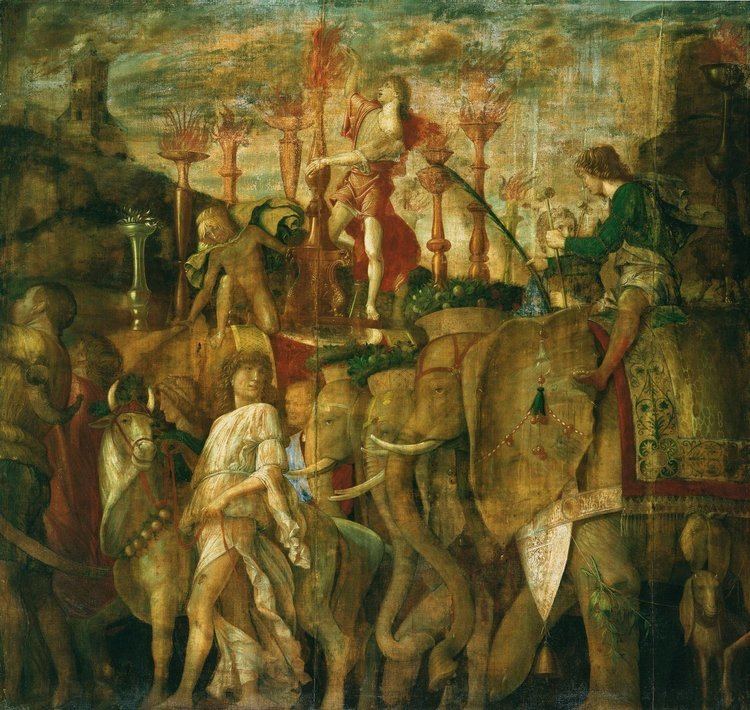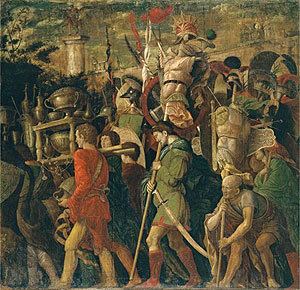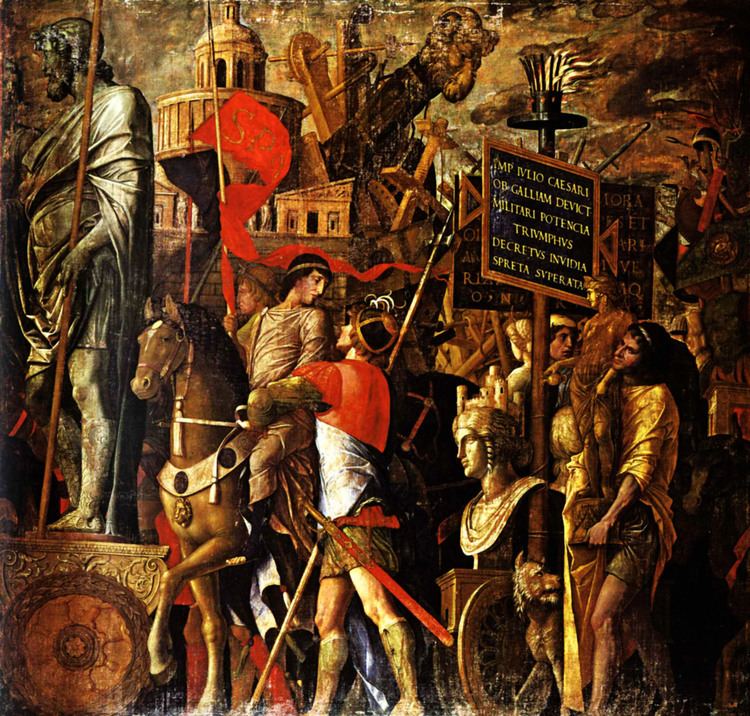Created 1486–1505 | Genre History painting | |
 | ||
Similar Andrea Mantegna artwork, History paintings | ||
Triumphs of caesar mantegna
The Triumphs of Caesar are a series of nine large paintings created by the Italian Renaissance artist Andrea Mantegna between 1484 and 1492 for the Gonzaga Ducal Palace, Mantua. They depict a triumphal military parade celebrating the victory of Julius Caesar in the Gallic Wars. Acknowledged from the time of Mantegna as his greatest masterpiece, they remain the most complete pictorial representation of a Roman triumph ever attempted and together they form the world's largest metric area of renaissance paintings outside Italy. Acquired by Charles I in 1629, they now form part of the Royal Collection at Hampton Court Palace in Greater London. Originally painted in the fragile medium of egg and glue tempera on canvas, the paintings underwent successive repaintings and restorations through the centuries.
Contents
- Triumphs of caesar mantegna
- Origins and setting
- Reception and influence
- Later History of the Triumphs
- 1960s Restoration
- References

Origins and setting

The Triumphs of Caesar were initially painted during 1484-1492 for the Ducal Palace in Mantua, commissioned by either the Duke Federico I Gonzaga or, more likely, his son Francesco II.

"We can see grouped and cleverly arranged in the Triumph the ornate and beautiful chariot, the figure of a man cursing the victorious hero, the victor's relations, the perfumes, incense and sacrifices, the priests, the bulls crowned for sacrifice, the prisoners, the booty captured by the troops, the rank of the squadrons, the elephants, the spoils, the victories and the cities represented in various chariots, along with a mass of trophies on spears, and with helmets and armour, headgear of all kinds, ornaments and countless pieces of plate."
Reception and influence

The Triumphs of Caesar were described as "the best thing Mantegna ever painted" by Giorgio Vasari in his celebrated Lives of the Artists. They rapidly became extremely famous throughout Europe, principally through copies in print form, of which many different versions were made, starting with a contemporary set from Mantegna's own workshop. Between 1517 and 1519, Hans Holbein the Younger, using prints, painted a copy of the work on nine exterior panels of the Hertenstein House in Lucerne, now demolished. Andrea Aspertini (1558-1629) made prints of the paintings in Mantua.
Later History of the Triumphs

The Gonzaga dynasty was overthrown in the late 16th century, and the major part of their painting collection was acquired by Charles I of England in 1629, using as an agent in Italy, the courtier Daniel Nys. The collection also included works by Titian, Raphael and Caravaggio. They arrived in 1630 at Hampton Court Palace, where they have remained ever since. The Lower Orangery was originally built to house Mary II of England's collection of botanical specimens. It was chosen as a setting for the series, since it re-creates the interior of the Palace of San Sebastiano in Mantua, Italy, where the paintings were hung from 1506 in a specially built gallery. The paintings are displayed as a continuous frieze, separated by small columns.

After the execution of Charles I in 1649, the Triumphs were listed in an inventory and valued at 1,000 pounds; (£NaN as of 2017) the entire Gonzaga acquisition cost 25,000 pounds.(£NaN as of 2017). Oliver Cromwell refrained from selling these paintings, almost alone among Charles's collection, due to their fame, and perhaps as they celebrated a general like himself rather than a monarch or Catholic religious theme.
1960s Restoration
The paintings had so deteriorated that visitors in the 19th century deplored their condition. In the 1960s a careful restoration to reveal the original paintwork was conducted on all but the seventh canvas, where no trace had been left by previous restorers. Although now mere shadows of Mantegna's cinquecento paintings, they still convey a powerful impression of epic grandeur. In the words of Anthony Blunt, who as Surveyor of the Queen's Pictures supervised the restoration, "The Triumphs may be a ruin but it is a noble one, one as noble as those of ancient Rome which Mantegna so deeply admired."
Art critic Tom Lubbock, writing about the restored paintings called pictures " the epitome of Renaissance art in the service of state power – they carry a powerful sense of inexorable procession – impressing the viewer with the inexhaustible quantity of available power and plunder."
The series is now displayed to the public under low level electric light for conservation reasons.
Copies of the paintings were made in the early 17th century by Ludovico Dondi.
